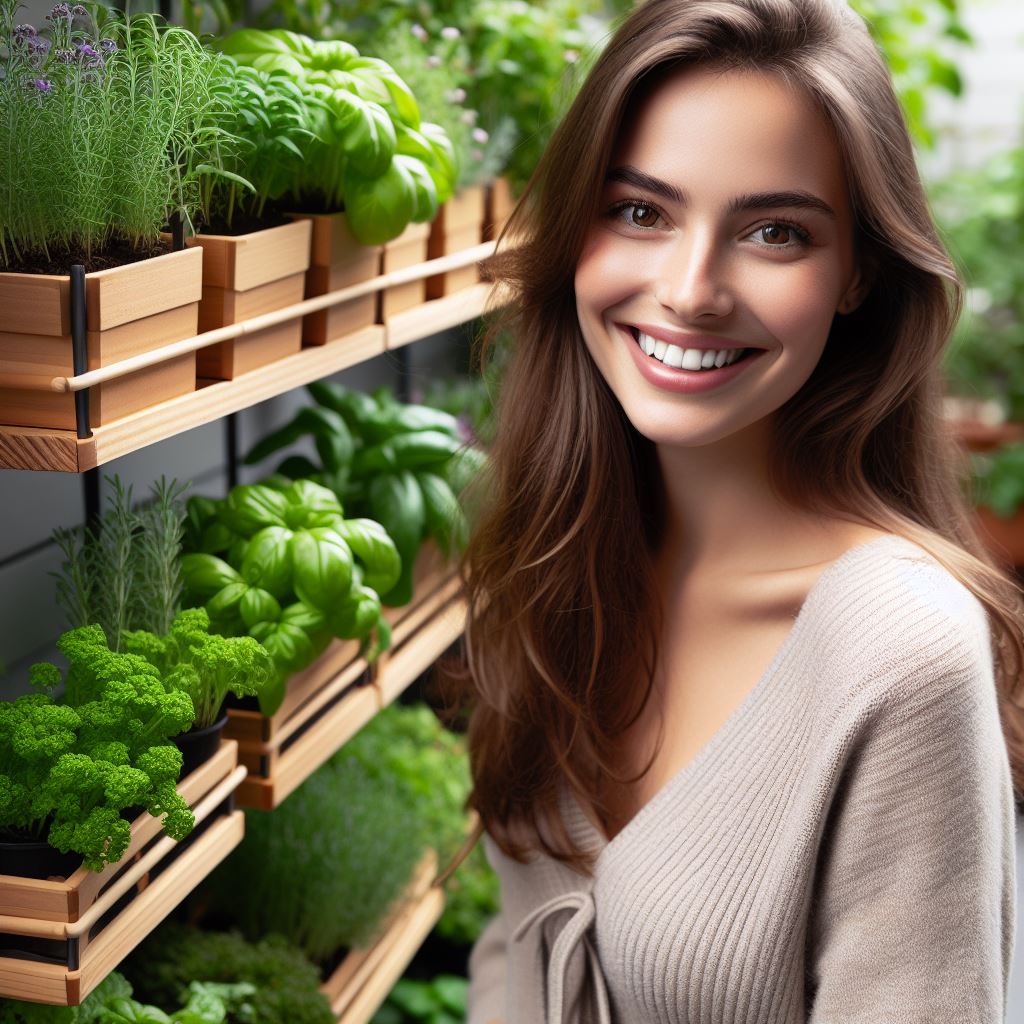Introduction
Vertical gardening has gained popularity due to its numerous benefits such as maximizing space.
By growing plants vertically, you can make the most of limited garden areas or small balconies.
It allows people living in urban environments to enjoy the pleasures of gardening.
Vertical gardens also offer aesthetic appeal, creating stunning green walls and beautiful displays.
This blog post explores how climbing plants can be effectively grown in containers.
Container gardening is a great option for those with limited space or balcony gardens.
Climbing plants are ideal for vertical gardening as they naturally seek out structures to climb.
Using containers strategically, you can guide climbing plants to grow vertically and optimize space.
This method allows you to create a lush garden even with limited ground areas.
You can grow a variety of climbing plants in containers, including vegetables, herbs, and flowers.
Choosing the right containers and providing proper support are crucial for successful vertical gardening.
With the right techniques and care, you can enjoy a bountiful harvest and a vibrant vertical garden.
In the following sections, we will explore the steps and considerations for growing climbing plants in containers.
From selecting the right plants to maintaining optimal growing conditions, this post covers it all.
Advantages of Vertical Gardening
Vertical gardening offers numerous advantages that make it an attractive option for both experienced and novice gardeners.
Transform Your Agribusiness
Unlock your farm's potential with expert advice tailored to your needs. Get actionable steps that drive real results.
Get StartedHere are some reasons why you should consider incorporating this technique into your gardening repertoire.
A. Utilizes limited space efficiently
Firstly, vertical gardening allows you to make the most of limited space.
In today’s world, where many people live in apartments or houses with small yards, this is a game-changer.
Instead of having to sacrifice gardening altogether, you can utilize vertical space, such as walls and fences, to grow a wide variety of plants.
By going vertical, you can transform even the tiniest balcony or patio into a lush green oasis.
B. Provides a solution for urban gardening
Secondly, vertical gardening provides an ideal solution for urban gardeners.
In cities, green spaces are scarce, and traditional gardens may be impossible due to limited land availability.
However, with vertical gardening, you can create a thriving garden in any small corner or even on a rooftop.
This not only allows urban dwellers to reconnect with nature but also helps improve air quality and reduce the urban heat island effect.
C. Enhances aesthetic appeal of the garden
Furthermore, vertical gardens enhance the aesthetic appeal of any outdoor space.
The lush, cascading foliage of climbing plants creates a stunning visual display that is sure to impress.
Whether you choose to grow flowers, herbs, or vegetables, vertical gardening adds depth, texture, and color to your garden.
It also offers endless possibilities for artistic arrangements and creative designs, making your garden a true work of art.
D. Reduces the risk of pests and diseases
Additionally, vertical gardening is beneficial in terms of pest and disease control.
As plants are elevated off the ground, they are less accessible to common garden pests like slugs and snails.
This reduces the risk of crop damage and allows your plants to thrive without the constant need for pesticides.
Furthermore, the improved air circulation in vertical gardens helps prevent the spread of diseases, as damp conditions that favor pathogens are minimized.
In general, vertical gardening is a fantastic way to make the most of limited space, especially in urban areas.
It offers a solution for urban gardeners who are limited by lack of land and helps beautify any outdoor space with its aesthetic appeal.
Moreover, vertical gardening reduces the risk of pests and diseases, allowing for healthier and more abundant plants.
So why not give it a try and see the amazing benefits it can bring to your garden?
Read: Balcony Berry Bonanza: Grow Your Own
Selecting Climbing Plants for Vertical Gardening
Achieving a successful vertical garden relies heavily on choosing the right climbing plants.
Here are some essential considerations and a list of suitable vines for containers and vertical growth:
Showcase Your Farming Business
Publish your professional farming services profile on our blog for a one-time fee of $200 and reach a dedicated audience of farmers and agribusiness owners.
Publish Your ProfileA. Consider the available space and light conditions
- Determine the amount of vertical space you have and choose plants accordingly.
- Take note of the sun exposure in the area where you plan to place your vertical garden.
- Consider whether the location is shaded, partially shaded, or receives full sunlight.
- Research climbing plants that thrive in the specific light conditions of your intended space.
- Ensure that the chosen plants’ requirements match the available light for optimal growth.
B. The growth habits and requirements of various climbing plants
- Take a close look at each plant’s growth habits, specifically how they climb and attach to structures.
- Some plants twine around support structures, while others use tendrils or aerial roots for climbing.
- Consider the structural support you plan to provide and choose plants that will thrive in it.
- Consider the water and nutrient requirements of the plants while ensuring proper drainage in containers.
- Check the hardiness zone of each plant to ensure it can withstand your local climate.
C. Choose vines that are suitable for containers and vertical growth
- Climbing Roses: These classic flowers add elegance to vertical gardens and are suitable for containers.
- Clematis: Known for their stunning and vibrant flowers, clematis is an excellent choice for vertical growth.
- Passionflower: These unique plants produce exotic, colorful flowers and are perfect for containers.
- Sweet Peas: Fragrant and delicate, sweet peas are ideal for bringing a touch of beauty to vertical gardens.
- Trumpet Vine: With its trumpet-shaped flowers, this vine is ideal for attracting hummingbirds to your garden.
- Hops: Besides being used in brewing, hops add a lush and decorative touch to vertical gardens.
- Black-Eyed Susan Vine: These vines produce cheerful blooms and can be easily trained in containers.
With a variety of climbing plants suitable for vertical gardening, you can create a stunning and space-saving green oasis.
Remember to carefully consider the available space, light conditions, growth habits, and requirements of the chosen plants for a successful vertical garden.
Read: Window Box Farming: Herbs & Greens
Container Selection and Preparation
Proper container selection and preparation are essential for successful vertical veg gardening.
The choice of containers can directly impact the health and growth of your climbing plants.
Here are some important factors to consider:
A. Opt for containers with proper drainage
- Drainage is crucial for the health of your climbing plants.
- Choose containers with drainage holes to prevent water from pooling and damaging the roots.
- Avoid using containers without drainage holes, as it can lead to root rot.
In order to maintain healthy plants, proper drainage is crucial.
Without proper drainage, water can accumulate in the container, leading to root rot and other issues.
Therefore, it is important to choose containers with adequate drainage holes.
B. Importance of lightweight containers for vertical gardening
- Vertical gardening requires containers that are easy to move and hang.
- Opt for lightweight containers to ensure easy installation and maintenance.
- Consider plastic or resin containers that are both lightweight and durable.
Vertical gardening often involves installing containers on walls, fences, or other structures.
Using lightweight containers makes installation and maintenance easier.
Plastic or resin containers are excellent options as they are lightweight and durable.
C. The need for trellises or supports to train the climbing plants
- Vertical gardening relies on trellises or supports to guide climbing plants.
- Choose trellises made from materials such as wood, metal, or bamboo.
- Ensure that the trellis or support is sturdy enough to bear the weight of the plants.
Vertical gardening relies on trellises or supports to guide climbing plants in an upward direction.
Choose a trellis or support made from sturdy materials such as wood, metal, or bamboo.
Ensure that it can support the weight of the climbing plants as they grow.
By carefully selecting containers with proper drainage, opting for lightweight options, and providing adequate support for climbing plants, you can create a thriving vertical veg garden.
These considerations will help ensure the success of your vertical gardening project by providing the necessary conditions for healthy growth.
Read: Tiny Soil Science: Perfecting Pot Mixtures
Planting Techniques for Vertical Gardening
When it comes to vertical gardening, proper planting techniques play a crucial role in the success of your plants’ growth.
Here are some important tips to keep in mind:
A. Use high-quality potting soil mixed with compost
The quality of the soil is essential to provide the necessary nutrients and moisture for your climbing plants.
Choose a potting soil that is rich in organic matter and mix it with compost to enhance its fertility.
The combination of potting soil and compost creates a nutrient-rich environment that supports healthy growth and development.
It also improves the soil’s drainage and water retention, preventing waterlogged roots.
B. Plant the climbing plants close to the container’s edges
Placing the climbing plants near the edges of the container allows them to easily access the support structures, such as trellises or fences.
This proximity enables the plants to grow vertically and utilize the available space efficiently.
Additionally, positioning the plants close to the container’s edges ensures that they receive maximum sunlight and air circulation, both of which are essential for robust growth.
C. Demonstrate proper planting depth and spacing for optimal growth
Each climbing plant has its own specific planting requirements when it comes to depth and spacing.
Consider the recommendations for each plant to ensure optimal growth and prevent overcrowding.
Planting too shallow or too deep can adversely affect the establishment and development of the plant.
It is crucial to follow the recommended planting depth to provide adequate stability and nutrient absorption.
Similarly, giving enough space between the plants allows for proper air circulation and reduces the risk of diseases.
Overcrowding can result in stunted growth, nutrient competition, and increased susceptibility to pests and diseases.
In essence, utilizing high-quality potting soil mixed with compost, planting the climbing plants near the container’s edges, and following proper planting depth and spacing are essential techniques for successful vertical gardening.
By employing these techniques, you can ensure optimal growth and create a stunning and productive vertical garden.
Read: Portable Plots: Mobile Garden Strategies

Maintenance Tips for Vertical Gardening
A. Provide sufficient water and ensure proper drainage
Maintaining a vertical garden requires attention and care to ensure its success.
Adequate watering and drainage are essential for the health of climbing plants.
Ensure the soil remains evenly moist, but never waterlogged.
Well-draining containers with proper drainage holes prevent water accumulation that may lead to root rot.
Showcase Your Farming Business
Publish your professional farming services profile on our blog for a one-time fee of $200 and reach a dedicated audience of farmers and agribusiness owners.
Publish Your ProfileB. Regularly check for pests and diseases
Regularly monitoring your vertical garden for pests and diseases is crucial.
Check for signs of common garden invaders such as aphids, spider mites, or snails.
Swiftly remove any infected leaves or plants to prevent the spread of diseases.
Consider implementing natural pest control methods, such as introducing beneficial insects or using neem oil.
C. Regularly prune and train the climbing plants
To keep your vertical garden neat and visually appealing, make pruning and training a regular practice.
Trim off any dead, damaged, or excessively long parts of the climbing plants.
Pruning encourages bushier growth and prevents tangling, ultimately leading to better overall plant health.
Guide the vines in the desired direction by gently tying them to trellises or support structures.
D. Importance of fertilization and soil amendments
Fertilization and soil amendments play a vital role in maintaining a thriving vertical garden.
Regularly feed your plants with a balanced liquid fertilizer every two to four weeks.
Organic fertilizers or compost can be used to enrich the soil and provide essential nutrients.
Consider incorporating slow-release granular fertilizers or applying organic mulch for long-term nourishment.
Remember to routinely check the pH level and nutrient composition of the soil, making adjustments as necessary.
Each plant has unique nutritional requirements, so it’s essential to understand their needs and provide proper nourishment.
Regularly monitor the health and growth of your climbing plants, adjusting maintenance practices accordingly.
In a nutshell, successful vertical gardening requires adequate watering, vigilant pest and disease control, pruning and training of climbing plants, and proper fertilization and soil amendments.
By following these maintenance tips, your vertical garden will flourish, providing you with a beautiful and productive space for growing climbing plants in containers.
Harvesting and Using Vertical Vegetables
A. The convenience of harvesting from vertical gardens
- Vertical gardens make harvesting easier and more accessible.
- Benefit from less bending or stooping over, reducing strain on your back.
- Harvesting is efficient since plants are organized and clearly visible.
- Enjoy the convenience of picking fresh vegetables at your own time and pace.
- Vertical gardens maximize space, allowing you to grow more vegetables in a smaller area.
B. Ways to use fresh vertical vegetables in cooking
- Add vibrant colors and flavors to your salads with fresh vertical vegetables.
- Include them in stir-fries, soups, and stews for added nutrition and taste.
- Create mouthwatering vegetable skewers for grilling or roasting.
- Bake them into casseroles, quiches, or frittatas for a delicious twist.
- Blend vertical vegetables into smoothies or juicing recipes for a healthful boost.
C. Tips for preserving excess produce through canning or freezing
- Consider canning vertical vegetables by pickling or using them in chutneys and relishes.
- Freeze excess produce by blanching them first to maintain flavor and texture.
- Label and date your frozen vegetables for easy identification and tracking.
- Vertical vegetables can be pureed and frozen in ice cube trays for future use in sauces or soups.
- Dry herbs from your vertical garden to have flavorful seasonings all year round.
By taking advantage of the convenience offered by harvesting from vertical gardens, you can easily enjoy the fruits (or vegetables) of your labor.
With fresh vertical vegetables at your disposal, the possibilities in the kitchen are endless. Incorporating them into various dishes adds an instant burst of flavor, color, and nutrition.
Additionally, when your vertical garden produces an abundance of vegetables, it’s essential to know how to make the most of it.
Preserving your excess produce through canning or freezing ensures that nothing goes to waste.
By pickling, making chutneys, or using them in relishes, you can savor the taste of your vertical garden’s harvest all year long.
Blanching and freezing vegetables also allow you to enjoy them later without compromising their quality.
Finally, drying herbs from your garden provides aromatic seasonings that will enhance your cooking no matter the season.
Harvest, cook, and preserve – the cycle of vertical gardening is complete.
Conclusion
Vertical veg gardening offers numerous advantages and techniques.
By growing climbing plants in containers, gardeners can maximize space, increase crop yield, and improve air circulation.
We encourage readers to engage in vertical gardening as a sustainable and space-saving option.
Whether you have a small balcony or a backyard, vertical veg gardening is a creative and rewarding way to grow your own fresh produce.
Not only will you save space, but you will also contribute to a greener environment.
So start your vertical veg garden today and reap the bountiful benefits!




